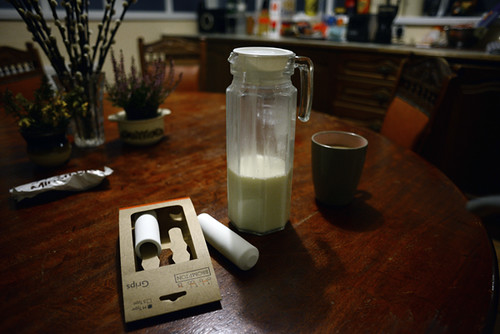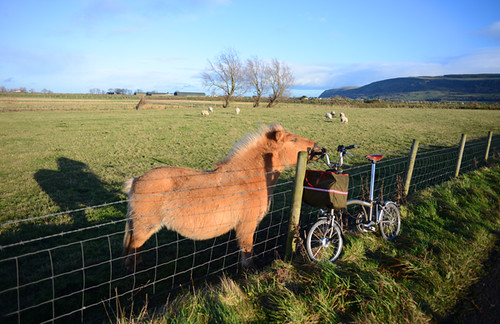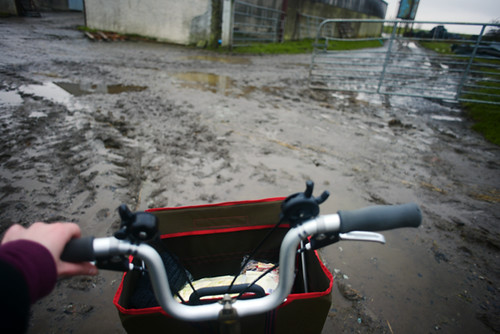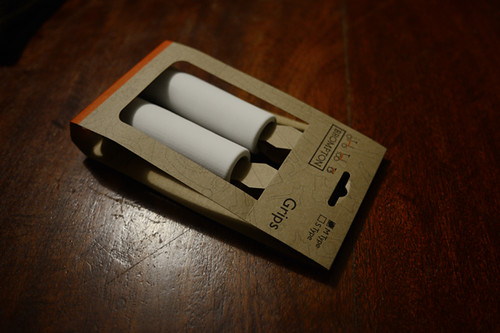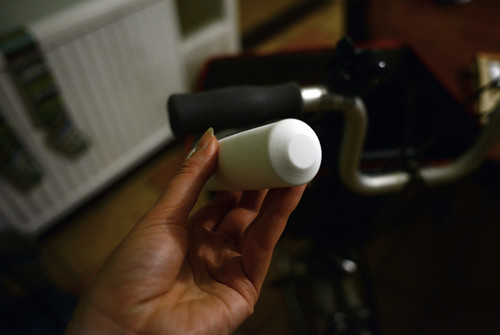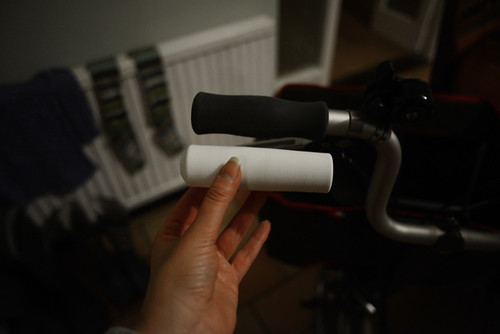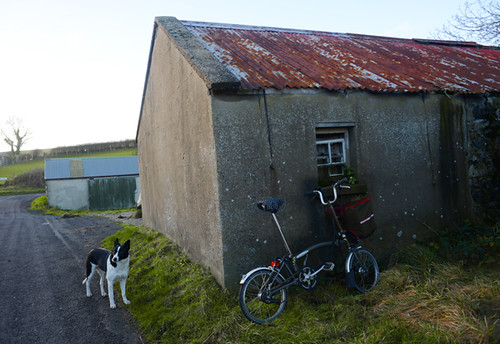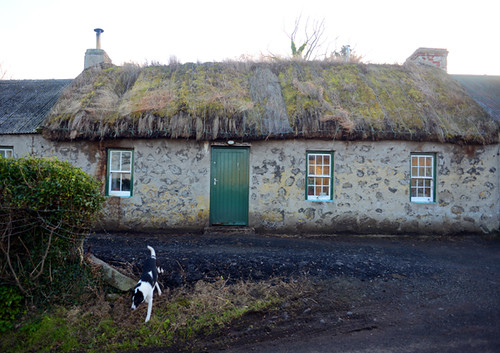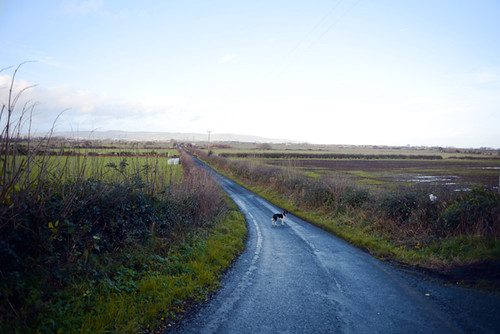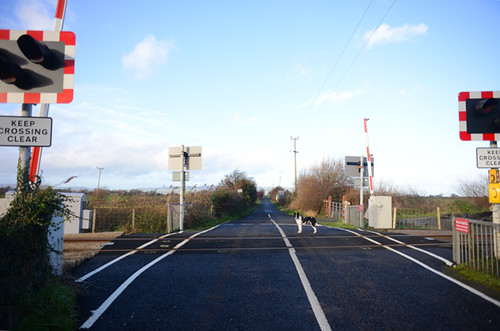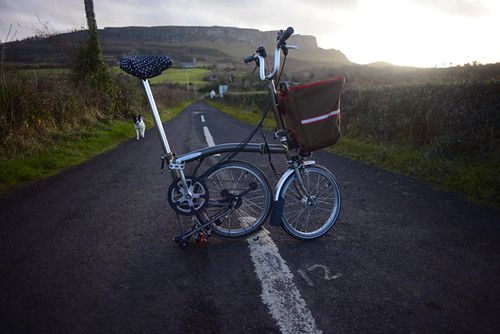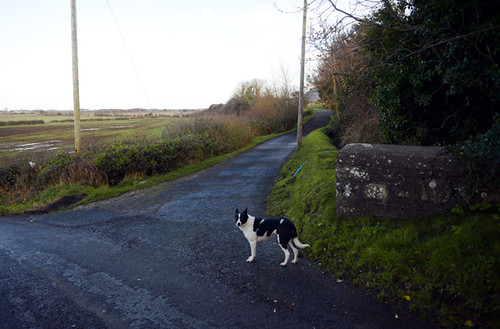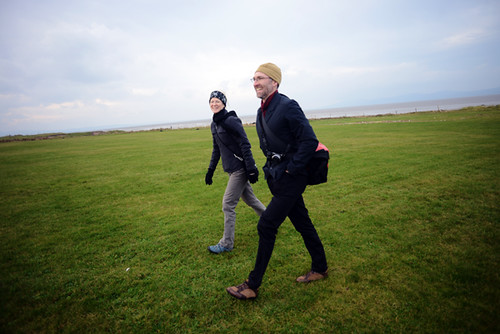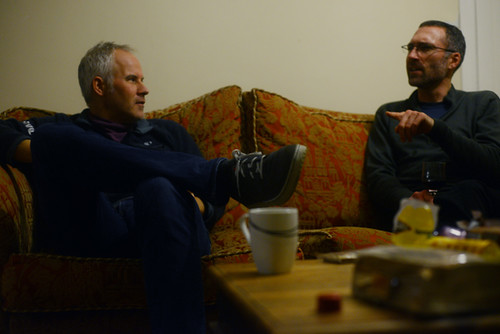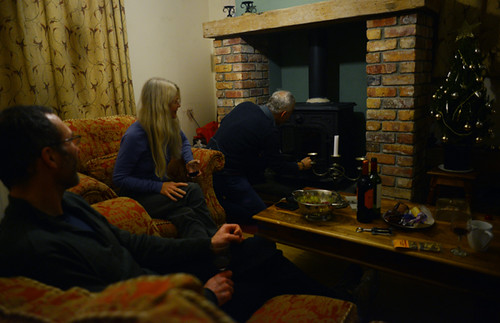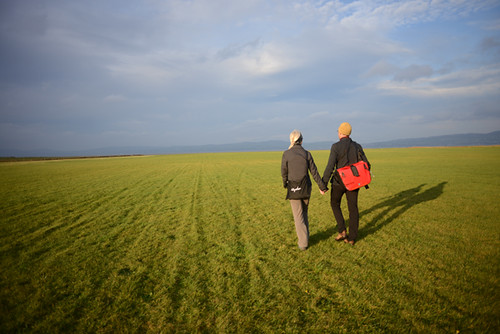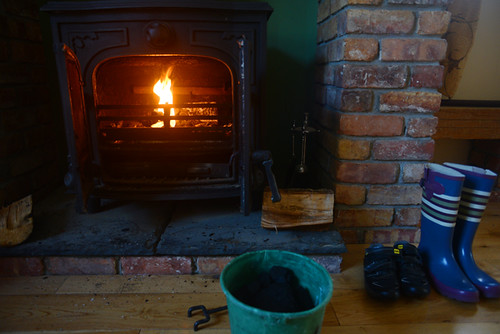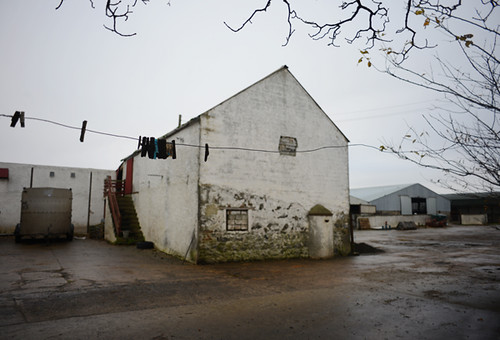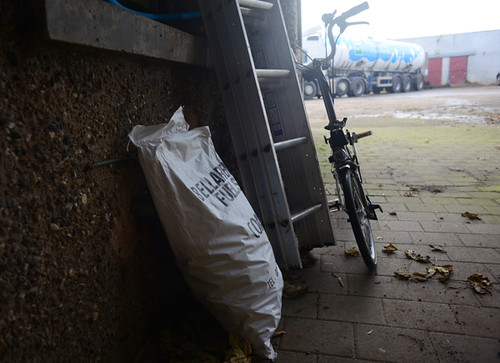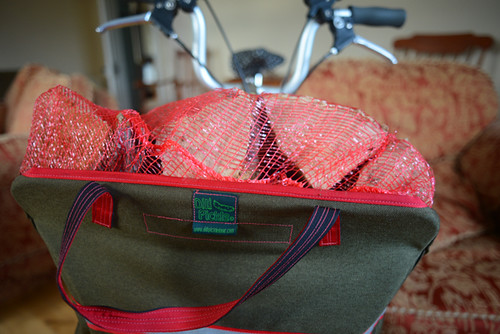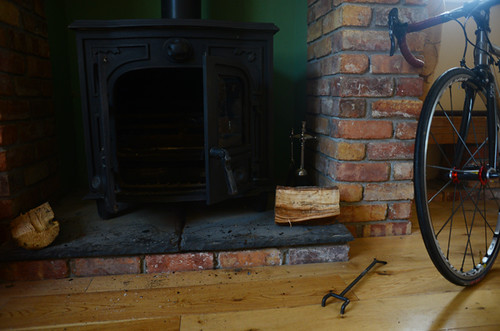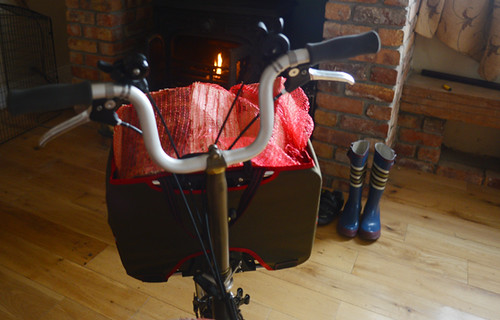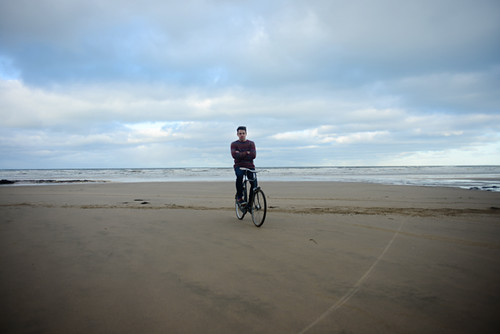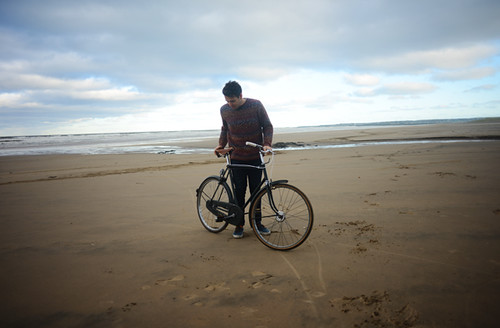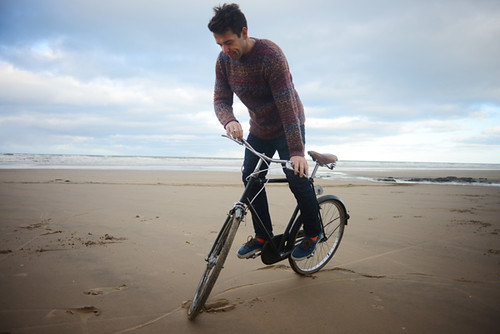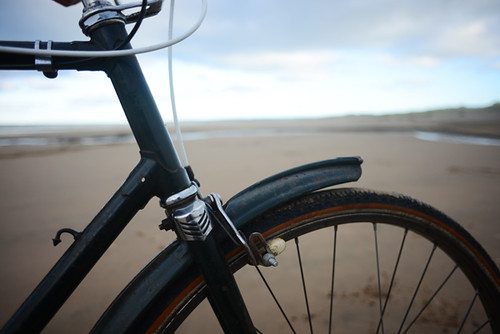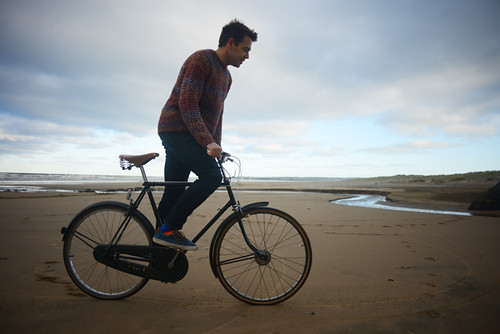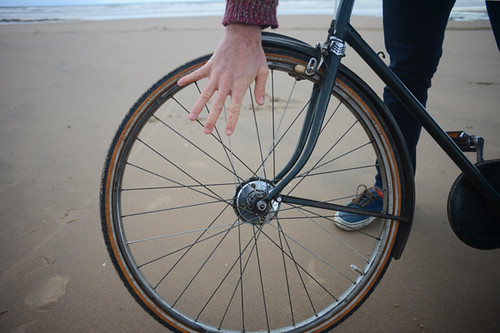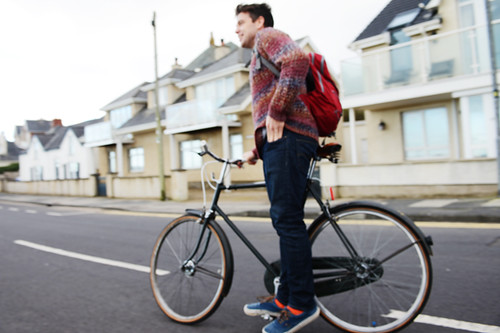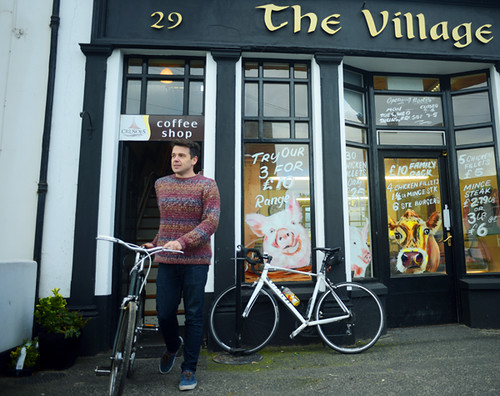In these last days of the year, there's been, as usual, a great deal of talk about New Year's resolutions. And after hearing some friends say their resolution was to cycle more in 2014, I finally suggested - why not now? Because I can't help but feel that the very point of a resolution is to delay this activity you are supposedly resolved to do, to find an excuse for not doing it already. As a result, this thing you put off until January becomes infused with dread and seems all the less appealing. And how sad it is that cycling should be put into such a category!
And so on this fine December 31st, upon my gentle prodding, we set off on a short photo expedition up the side of the mountain. It was a windy, but sunny and cheerful day. The ride turned out hillier than planned, but we did not complain, as fabulous vistas spread out under a perfectly clear sky as far as the eye could see. We even encountered an old acquaintance, who was happy to join us for a spell. It was one of those unexpectedly, spontaneously perfect days made all the better by being out on bikes.
Now I have done New Year's Day rides before, but never an Old Year's Day Ride. And I have to say I highly recommend it. As we cycled on this last day of 2013, we felt - on a delightfully visceral level - that we were pedaling away from 2013 and toward the blank slate of 2014.
So my message to you dear readers is… If you have time for a ride in these last hours of 2013, why not say "good bye to all that" on two wheels? Happy New Year to all and thank you for reading! I will see you again in 2014.
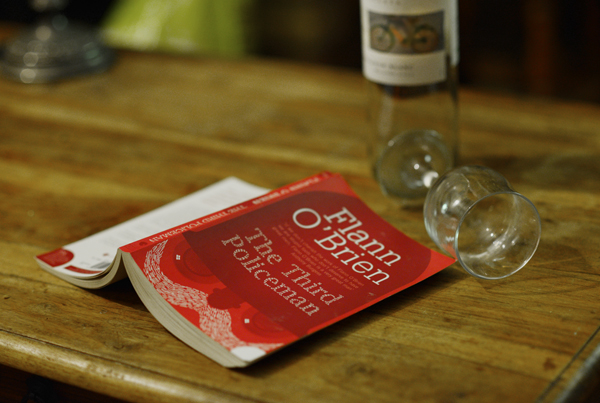
On this disconcertingly sunny day before New Year's Eve I am siting in a coffee shop in Coleraine, Northern Ireland. Past my table a smallish policeman wanders casually. He is dressed head to toe in protective gear, including a heavy bullet proof vest and an enormous face shield. No one but me pays him any attention. Heading for the rear of the shop, the policeman carries an object that resembles a briefcase made of oversized Legos, plastered with bright decals whose warnings my eyes can't discern in the dim interior. Some minutes later he re-emerges from the rear and - toylike briefcase firmly in hand - makes his way back across the room toward the exit, slowing his steps, it would seem, as he once again is about to walk past my table. For a moment I am certain - completely certain - that he intends to stop and say this very phrase to me. But he only throws a tired, face-shielded smile my way and walks out, and I remain there - mouth ajar, hand with coffee cup frozen in mid-air, and a copy of Flann O'Brien's The Third Policeman splayed open across my lap.
For some time I resisted reading this book, despite repeated suggestions that I really ought to. I shunned it due to an erroneous belief that it was a slapstick comedy detective story type of novel, to do with Ireland and a bunch of cycling policemen; I had so many other books to read that I could not be bothered with such a thing just then. Or so I said to myself. But in retrospect it is clear to me that my resistance to The Third Policeman was due to something else entirely - an intuitive knowing, if you will, that the book and all the information within it could prove hazardous for the delicate state of my mind. Because that it was, and is. While I am normally a quick reader, getting through The Third Policeman took me ages; it was too overwhelming to take in quickly. And at the end, I found myself conflicted between not being able to take much more of it, and not wanting it to end.
If you can imagine Master and Margarita crossed with The Naked Lunch, crossed with A Bit of Fry and Laurie, crossed with Waiting for Godot, crossed with almost anything by Thomas Pynchon… well, The Third Policeman is really nothing like that at all. But conjuring up such a hybrid might prepare you for it a little, maybe.
What is this book like, without giving too much away? I don't want to describe the plot or any of the details. Which is just as well, because what got to me was not any of that, but that the book tapped into - a little too realistically - my own experience of present-day rural Northern Ireland. Before you think this an attempt to be funny, let me explain that I refer not to the absurdity of the plot or specific encounters, but to Flann O'Brien's detailed portrayals of sensations, dialog, scenery and mannerisms. To be sure, he exaggerates and distorts grotesquely, and he re-shapes language. But in so doing he captures the essence of being here more poignantly than any other local author I have read. On top of this - or maybe because of it - his manner of communicating ideas (the kind of insane ideas I try to suppress in myself) is so delicate and subtle, it is easy to underestimate how deeply they penetrate the psyche until it's too late. Honestly, I will need to ride my bike for hours, possibly days on end, just to recover from the effect of this book.
And speaking of. I should move on to the important question for the readers of this blog: "Is this about a bicycle?" Well, since that might be the most quoted line in the book, the answer is a sort of yes. Except that it is really about language, metaphysics, the absurdity of organised society, and the pathology of everyday life. So on second thought… Sure, it is about a bicycle. After all, everything is.

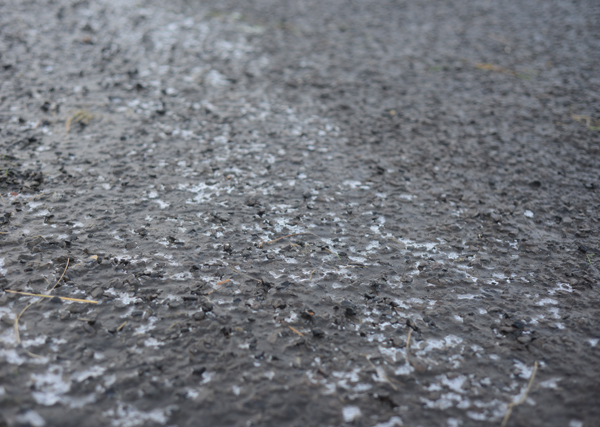
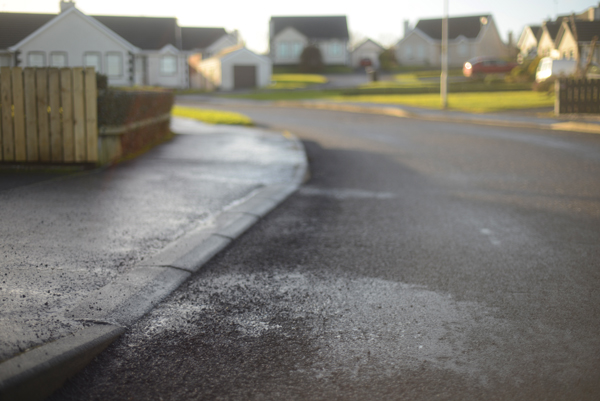
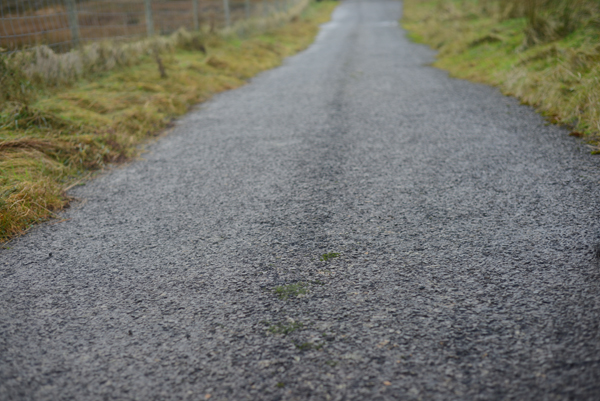
No, this brand of black ice had not the decency for any of it. It adhered to the contours of the chipseal in a matte, thin, perfectly transparent crust. It did not reveal itself in any visual manner what so ever, ensuring that its ice-rink quality slickness caught the traveler entirely by surprise.
Having discovered this treachery, I backtracked gingerly only to learn that even more of the road was covered with the stuff than I'd realised. What before had looked inviting now seemed hostile, even sinister - a formidable booby trap. A Boxing Day ride was not to be. But at least now I understand what I'm dealing with, and why the locals warn about it so zealously. Black ice is a force to be reckoned with, all the more so when its perfect stealth is matched by its perfect slickness. Even studded tires, I'm told, will not always help. This could be one long winter!
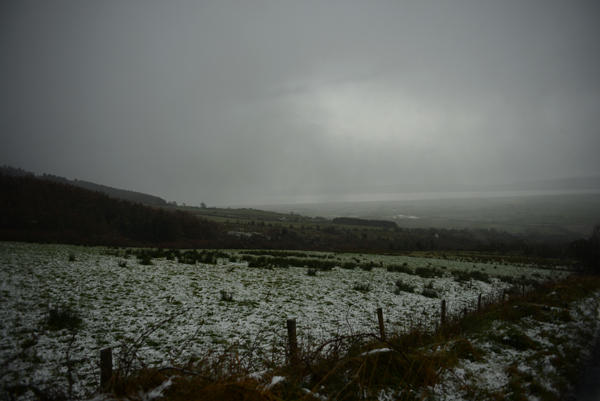
Well the weather outside is frightful
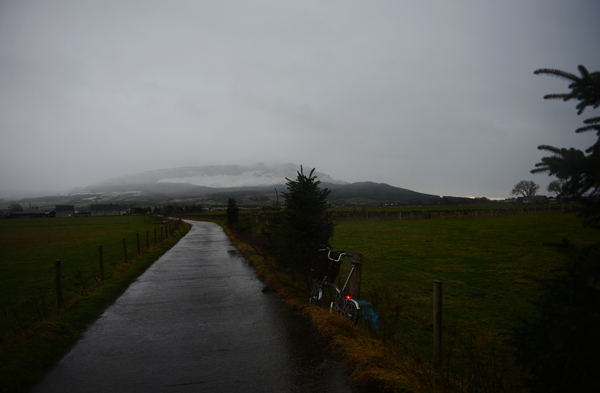
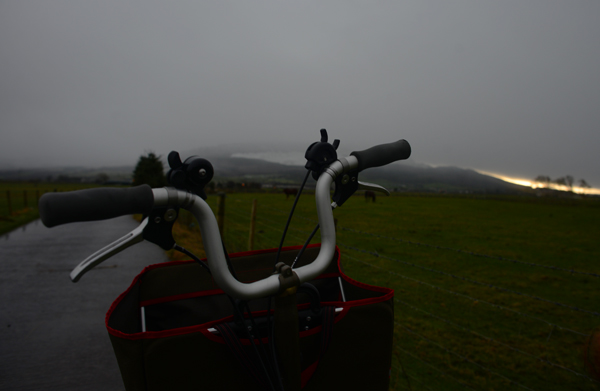
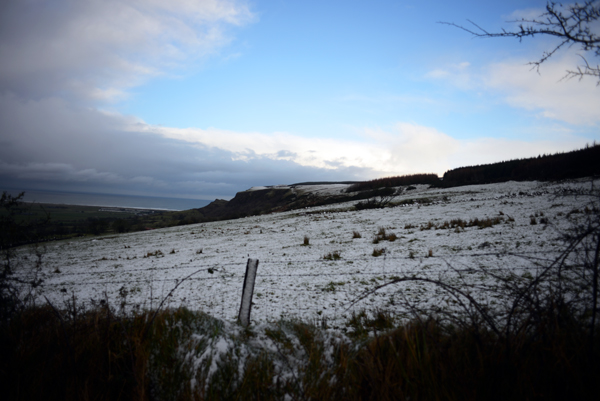
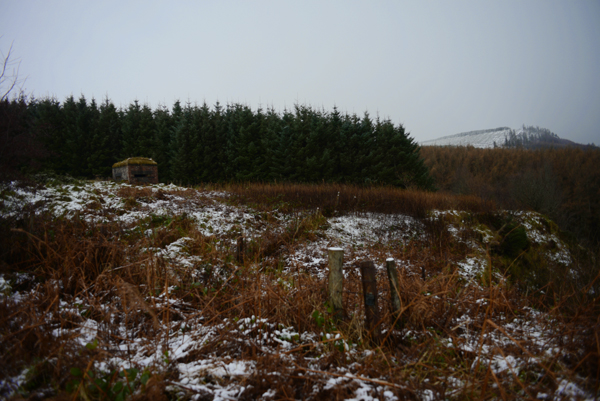
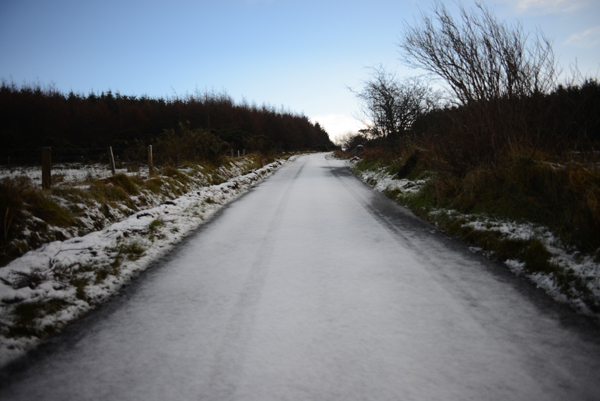
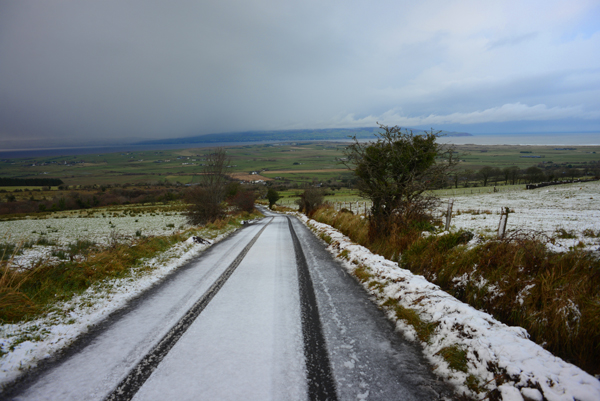

All throughout Autumn, the locals repeatedly warned me, a newcomer, about winter on the North Coast. These warnings were as ominous as they were vague. Just you wait till winter... It will get bad... Stay the winter and see if you still "like it" here!...
Now that the solstice is coming, I am reminded that winter is in full swing. And I get occasional inquiries into the progress of my opinion. On the day of a particularly bad storm, or a drastic temperature drop, someone will inevitably ask: "And how do you like it here now, eh?" - studying my wind-burned face with a hint of glee.
Granted, living here is not without challenges. The winter cold feels far worse than the temperature readings suggest, due to the nasty strain of dampness particular to these parts. The winds get so powerful, it can be difficult to walk, let alone ride a bike. Visibility can grow poor - and rapidly - due to sudden onset fog and flurries. While food is very affordable here, heating is problematically expensive and needs to be thought through carefully. None of this has put me off so far; I adjust. On non-windy, or mildly windy days, I try to get all my long-distance errands done. I have figured out how to get things delivered, if need be. Working from home, I try to time my work so that I'm out of the house in daytime and work mostly early morning and after dark - as its more efficient to heat the house that way.
Daytime lasts until about 4pm these days. Except on those badly overcast days when the sun never really comes out, and the 24 hour period is split into a state of complete darkness and semi-darkness. Those days have not been infrequent as of late. In fact today was one of them. Allowing myself to be pushed about by erratic gusts of wind, I cycled to the little farm shop down the road after riding a mildly hilly loop along the base of the mountain for purely recreational purposes. The light at 10:30am looked no different than the light at 3:30pm, all diffuse and veiled and, if you want to be unkind about it, dirty-dishwater-like. It is the sort of thing that I suppose should feel depressing, but isn't - instead awaking a part of me that is asleep in more overtly cheerful environs and inspiring a flurry of creative and productive activity.
The darkest days are here, and they are okay. I have bikes to ride and work to do and food to eat and logs to burn and people to talk to and animals to pet. The Winter Solstice is tomorrow and it will be the shortest day yet. Suddenly I feel like a bike ride to celebrate. Who else is planning a Solstice Ride?
After nearly two years of owning my Brompton folding bike, I am finally about to replace one of its parts due to wear and tear. To be fair, the components have all held up well so far, in all-weather conditions in New England and Ireland. But I am saddened to report that the foam grips have failed to stand up to the rigours of rural life. The cause of the damage? A horse. Of course.
Propping my bike against a farm fence a couple of days ago, I walked away a short distance to take some photos of the landscape. When I noticed the chubby creature making its way across the field toward it, I thought it was cute at first. She seemed so curious, making a beeline for the bike on her dimunitive legs with a brisk shuffle and an air of determination. And I thought it was cuter still when she got up close and personal and began sniffing the handlebars. At least that's what I thought she was doing. Alas, when I reached the bike I saw the situation was quite otherwise: A good chunk of the right grip had been chewn off.
Taken aback by such brazen impertinence, all I could do at first was rebuke her. "Pony, how could you?!"
In response to this, she glanced up at me with an expression of feigned innocence, all the while continuing to gnaw industriously. By the time I gained the presence of mind to yank my bike away, the grip was but a mangled mess of foam. Pedaling away, I shook my finger at the treacherous Shetland and wondered whether Brompton sold replacement spares.
Here I will backtrack to explain that I never imagined I'd be keeping the flimsy-seeming foam grips that originally came with my Brompton. In fact, I thought they'd be the first thing to go as I'd inevitably proceed to customise the bike. I considered ergo grips with extensions to allow for more hand positions. I considered leather grips in a caramel-brown colour to match my saddle. I considered colourful hard-rubber grips to add some firmness and zing to the so-called cockpit. But in the end I never bothered altering this bicycle in any way at all, and, like everything else on it, the original grips remained - proving perfectly comfortable just as they were. It just so happened they were the ideal size for my hands. And the foam itself was of a good consistency - cushy enough to absorb road shock, but not so cushy as to be too soft. I wasn't a fan of the drab gray colour, but this alone was not enough to make me forsake their comfort. And so the grips stayed and I grew to love them all the more - now wanting nothing but an identical replacement to the pony-ravaged one.
When I turned to Brompton for guidance, they informed me that they now sell replacement foam grips in their online shop. Not only that, but these grips now come in a selection of nice colours. Well then! In my excitement, I almost bought the overpriced little gems in red. But then my boring neutrals-loving side took over, and ultimately I went with the white - as an homage to the vintage 3-speed folders of yore.
Impressively, the grips arrived to my remote Northern Ireland abode in 2 days. And soon I was fondling their milky-white foaminess in anticipation of mounting them upon the handlebars.
But as I held them up to my old grips, I noticed something alarming: They were not quite the same. The consistency of the foam feels similar enough to the touch, but the replacement grips lack the curvature of the originals - namely, they're missing that middle bump around which the palm of my hand wraps so comfortably. Would holding these new grips feel the same, and dare I risk finding out?
As I contemplate this important question, I continue to cycle with my old grips for now, my right hand feeling the shredded texture through my glove. As I pedal past the shameless equine responsible for the deed, I shoot her what I hope comes across as a meaningful glance. But indifferent to my troubles, she merely shakes her head and makes a noise which is almost certainly a giggle.

I thought I had imagined it at first. Cycling along the Seacoast Road one day, I pedaled against a strong headwind. On the return trip along the same road not long after, I found myself struggling against a headwind again. How could this be? In this land, where sadistically steep hills, heavily textured road surfaces and other resistance-producing phenomena were so commonplace, was I not at least entitled to a return tailwind in accordance with the laws of physics?
Possibly I was mistaken in remembering there had been a headwind in the original direction. Yes, that must have been it, I decided. But several days later, the same thing happened again along this route - a route which, as "luck" would have it, had by now become a regular commute. I paid attention this time. Setting off late morning: headwind. Heading back early afternoon: headwind! Time after time, it was the same.
Just as I began to question my sanity, one day I heard some local pilots talking about a flight they were planning. And one of them mentioned off-handedly that the wind would be changing direction mid-day. My ears perked up.
"Wait, wait a minute. What did you say?"
"Oh sure. We get a sea breeze by the Lough Foyle here. Changes direction around 2pm."
"Sea breeze," eh? Well there's a euphemism if I ever heard one, considering how strong this wind can get. How lucky for me to get the headwind end of it. But at least I know I was not imagining it. And, decades from now, I'll be able to say to a room full of bored youngsters: "Back in the day, I rode my bike with headwinds in both directions."
Go. Go I said! Can't you tell I don't like dogs? I'm sure you can tell, you're supposed to have a sense for these things. Now can you please stop jumping all over me? And licking my hands? And looking at me like that? No really, come on now. You're in my shot. I am trying to take some photos here!
Right, here is what we're going to do. Come over here, and you can stand next to me - if you're quiet and don't jump on me, okay? Good. All right. Shoot, wait, what's this you're doing now? Oh no, come on!
Look, I'm flattered you trust me enough to show me your tummy. Really, it's a nice tummy. A fine tummy. Here, okay, I'll scratch it a little. Happy now? Okay, one more time. And then we part ways, yes?
Listen, it's nothing against you. I am just not a dog person. You're a nice dog, but go back to your farm now, okay? Look, I'm getting on my bike now. I'm going to pedal away. Take care!
For goodness sake, how can you run alongside me so quickly? I must have been nearing 20mph down that hill. Don't follow me, I'm cycling home. Now you go home too, you hear me?
Look, I am not racing you, okay? If anything I am trying to go slow in case you run out in front of my wheel. Do you have enough sense not to do that? I don't know you, so I've no idea you see - I have to be careful not to hit you. So don't look so smug as you stand there panting and waiting for me! And why do you keep waiting for me anyway when I've told you a hundred times to go home? Just how far are you planning to follow me?
Okay, seriously. We are nearing the main road and this has gone far enough. We are stopping and I am taking you home. You don't have a collar, so I can't even grab you, darn it. Do you want to go in the basket? No? Okay then, I am going to cycle back where I found you and return you to your owners. Are you ready to run along? Gosh, but you sure can go fast. And to give credit where it's due, I guess you do have enough sense not to run out in front of my wheel. Should I trust you and pick up some speed? Okay, race you to that bend. Go-go-go! Go-go-go-go-go!!! Okay well maybe this is kind of fun. You are one fast dog, let me tell you. I'm panting more than you are! Here comes the bend. Go-go-go! Go-go-go-go! And ...it's a tie! Although wait, did you let me win?!
So... Here we are. I guess this is good-bye now? God, I hope your owners didn't think I stole you. You really shouldn't follow random people like that you know. I mean, I could have been a dog-thief or worse. What's that? Oh, you knew that I wasn't? Well aren't you clever. And what else did you know? Oh really, that I'd like you once I got to know you and would play with you if you insisted long enough? Smarty pants. But okay, look... I do like you. And I had a good time. And you did look kind of cute running beside me, with the wind in your ears. So I'll see you around, okay? And yes, I will be on my bike again. Maybe I'll even win next time.
To watch The Blayleys walk across the pasture beside my house felt surreal, if only because it seemed so natural. John Bayley is Irish, so his presence registers as entirely normal here. But also, Ireland just doesn't feel that far from the Greater Boston area. It was almost as if we were meeting in rural Vermont or Western Massachusetts. Well, not quite. But the setting did not feel wildly foreign.
What did feel foreign was the complete absence of cycling. Pamela is still recovering from her injury earlier this year. And they were not staying long enough to make it worthwhile for John to bring a bike along. So here we were - interacting not as three cyclists, but simply as three people. Meeting at the train station, we walked to my house along the country roads as the sun set over the mountain. Then we lounged indoors by the fire until 2 in the morning.
Throughout the evening, others came. For a place as remote and under the radar as Northern Ireland, it is surprising easy to end up in serendipitous situations. Cycling persona Dave Smith - aka @ffflow - happened to be in the area. Now here he was, at my house, in the flesh, bearing a bottle of wine and stories that had nothing to do with cycling. International man of mystery Clive Somerville joined us as well, just back from a trip to Abu Dhabi. Wine and food appeared. Introductions were mostly dispensed with. Conversations began from the middle and went in unexpected directions, as if we all knew each other better than we did.
How does that happen exactly? None of us were from the area. And all had had something unusual happen to us in recent times. Maybe that was the common thread, the disinhibiting factor. As well as the knowledge that we were all connected by our love of bicycling, even if the topic was hardly mentioned.
I used to think that I would not know what to do outside a cycling context with those whom I knew through cycling. This year has proved that to be entirely wrong. And as strange as 2013 has been, that is one thing I am grateful to it for.
In the morning, I walked with Pamela and John to the shore, across the fields of faded grass. Pamela is tough and resilient, and the next time we meet we could very well be riding bikes together. But, as with my other guests from last evening, the cycling aspect seems almost irrelevant now to our connection. The threads that bound us might be threads of wool and lycra, but somehow they have helped us transcend the realm of cycling.
Moves can take place in stages, and as I moved from the village of Castlerock to the village of Bellarena some miles to the west down the coastal road, there was a period defined by a constant stream of going back and forth - of moving things into the new house bit by bit while working to make it livable. Sometime in the midst of this, I made the mental switch and began to think of the new place as home. It happened not the first time I spent the night there, but on the day I brought over my roadbike - by means of riding it from the old house to the new.
Setting off from the small seaside cottage where I had stayed - with its beige pebbled walls, its slate shingle roof and its cramped front yard - I felt a keen awareness that this would be my last ride out of this place. This stunningly beautiful, windswept place I could not wait to leave behind. Clipping in, I took one last look at it all as I pushed off into the wind that never seemed to subside.
The tiny house was an old one - built as a residence and not as a holiday cottage, unlike most of the others nearby. And unlike the others, it was built at a slight angle to the road, with complete disregard for the sea that spread out across it. Of all the windows, only a single one in the livingroom faced the water. And mystifyingly, the layout of the room was such as to discourage its occupants from facing that window - the fireplace on the wall opposite serving as the focal point. Stranger still, even should they turn around to look through the sea-facing window, their view would be mostly obscured by the fence enclosing the yard out front.
On countless occasions I've wondered why the house was built this way - almost willfully snubbing the dramatic seascape that ought to be a home-owner's dream. Could it be for the same reason the scenery made me uneasy? Could it be for the same reason the relation I'd been house-sitting for had picked up and left abruptly after less than a year there? Some believe that places can have a "bad vibe," and that is an apt description for what I've felt here. I felt it not from the house, but from the area. The house's layout almost seems like evidence that the architect had felt it too, and tried to protect the inhabitants from it.
For some, to say that you live in Castlerock has a certain caché to it. It is a "posh" place - the village center dense with old Georgian houses, the train station almost toy-like with its wrought iron latticework. The local coffee shop - its atmosphere chic and worldly - is said to be among the best in Northern Ireland. The butcher shop next door delights passers-by with its old fashioned window display. There is one pharmacy. There is one small grocery store. There are two pubs - one with a weekend disco. There is a fish and chip shop with a mural of a grinning fish serving customers. There is a pedestrian culture, with tweed-clad residents strolling up and down the hilly lanes as ocean waves crash picturesquely in background. Crowds of young surfers flock to the beach in vans covered with sponsor logos.
In comparison Bellarena is perceived as isolated and rural-rough, my delight over moving there often met with some bewilderment. But there are those who understand - those who shake their heads and even let out a slight shudder at the name Castlerock. "I could not live there either," they say simply, and we leave it at that.
To describe the daunting feeling of cycling "out of" Castlerock toward the main crossroads is to concede there is a strong psychological side to going out on the bike. There is a heavy, dead sensation to that barren 1 mile stretch that separates the village from the main coastal road and the network of mountain roads beyond it. This sensation can only partly be explained by the fact that this stretch is entirely uphill and nearly always supplemented with headwinds. But this alone cannot fully explain the overwhelming tediousness of it, the emotionally draining effect this mild ascent has on me by the time I reach the crossroads. As I stall my bike waiting to turn right onto Seacoast Road, Castlerock feels like a led blanket I am desperately trying to claw my way out from underneath of. The knowledge that this awaited me at the start of every ride, dampened my enthusiasm for roadcycling more than I would have thought possible.
Some time after I moved to Castlerock, a policewoman friend told me the story of the murder at the 12 Apostles - a row of refurbished stone cottages scenically situated at the edge of the woods. Some years ago, a man who lived there and his mistress - each married and with many children apiece - made a pact to kill their spouses. They went through with the plan and got away with it, until, two decades after the fact, the man walked into the local police station and confessed to it all, unable to live with the guilt. This was all over the local papers at the time, the Castlerock population shaken. To think, that for all those years the pair was living here, harboring their secret. As I make my way past the cottages, I cannot help but remember this.
The village of Bellarena is not really a village as such, but more like a scattered rural settlement on the Magilligan Peninsula - on the other side of Binevenagh Mountain from Castlerock. The best way to get there is via the Seacoast Road that runs along the mountain side. The first part of this route is ludicrously scenic - a seemingly endless sweeping descent with postcard views of the sea framed by tall cliffs and the famous silhouette of Mussenden Temple. No matter how many times I cycle along this stretch of road, I have never been able to warm to this descent and this view. It feels unreal, in the cold detached sense of the word. It feels as if it's designed for paintings and postcards rather than real-life enjoyment. The view cannot be connected with, it can only be observed from a distance - as if it's meant to feel unattainable.
As I plummet past the picture-perfect sight, I feel a rush of relief at the next, comparatively monotonous stretch of the road. I cycling along the steepest part of Binevenagh Mountain now - a vast cliff streaked with occasional slender waterfalls. To my left, this horizontal wall of rock creates perpetual shade, while on my right the sea is becoming obscured by fields and clumps of woods. I should feel claustrophobic here, but instead I feel pleasantly sheltered. And I feel as if I've crossed some invisible border that separates the stark, gloomy aura of Castlerock from the cozy, bright one of Bellarena, which I continue to cycle toward.
As the road curves along the Magilligan Peninsula, the mountain on my left grows less steep and more colourful with the remnants of Autumn foliage and heathery clumps. On my right, miles and miles of farmland spread toward the sea - which is about to narrow dramatically and become the Lough Foyle as I pass the peninsula's tip. I can see this happening in the distance, along with the hills of Donegal looming beyond. This last stretch is completely flat now, and I pedal at the highest cadence I can manage along the main road, vigilant so as not to miss the hidden narrow lane that will take me across fields toward the house where I'll now live. This was my last ride out of Castlerock and I breath a sigh of relief - overcome by a sense of escape. Escape from the stunning, cold, haunted beauty of a place that is not for me.
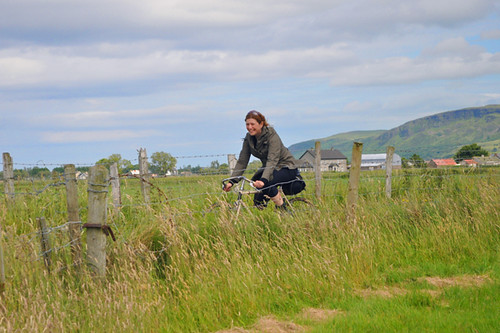 |
| image by Chris Sharp |
A good friend of mine here is a runner. He cycles as well, but it’s running that’s his passion. He runs mostly off road - on wooded paths, through forests and up mountain trails, along rugged shorelines. And when he talks about running, he makes it sound wonderfully appealing. So much so that, willfully suppressing awful memories of my own tortured attempts at running in the past, I began to ask questions and to consider giving it another try.
So we had a chat about it, at the end of which I said that I'd like to try running again - making a comment to the effect of “I think I'm going to enjoy it this time.” To this he quickly replied “Oh no, you’ll hate it at first for sure!"
"Oh?"
"But stick with it," he added brightly. "Once you pass the tipping point, you'll not be able to live without it."
Okay, not exactly what I had in mind. But I remained optimistic. "So how long did it take until you began to enjoy running?"
"About three months."
"Three months?!" Okay, definitely not what I had in mind. But the idea of willingly doing something that feels awful until that point where it begins to feel good intrigued me. What motivates people to run for 3 months if they don't enjoy it? And how does the experience transition from an unpleasant to a pleasant one?
When I started asking these questions, my friend turned the subject to cycling. "Well didn't you feel the same way on the bike? Is the pain not terrible until you get used to it?"
It never occurred to me to think of cycling in that way. Because no, it never felt terrible. It felt good from the get go - wonderful even - which is why I wanted to do it again and again. Sure I was sore and out of breath after my first few bike rides when just starting out. And even now I feel plenty of pain whenever I push my limits. But I would compare this to the experience of dancing all night: While I don't get to do this as often as I'd like nowadays, in my 20s I used to love going to clubs and dancing until near-collapse. I'd feel the physical stress toward the end, and definitely the day after. But while I'm dancing, the fun of it and the getting lost in the moment overshadow the pain. On a bike - whether toodling along a river path or taking part in the most grueling of training rides - I feel something akin to this. But at no point had I ever felt it while running; at no point during any of my attempts to run did it feel "fun," and at no point had I been able to lose myself in the act of running to the extent that the pain and discomfort of it would get tuned out. I had always thought this to be a sign that running was simply wrong for me, and assumed that dedicated runners got that way because they did enjoy it from the start. But now here was a runner telling me that he too was miserable in the beginning. I have since questioned a few other friends who run and got similar feedback. Their description of running as initially unappealing, but habit-forming, reminded me of the stories people tell of how they began smoking or drinking: "I hated the taste at first..." When it comes to stories of how people got into cycling, there is instead a theme of love at first try.
So, does running tend to be an acquired taste, whereas cycling is innately pleasurable? Or is it more about the person, the intensity, and other factors? I've stuck with cycling for 5 years because I loved it from the get-go, so the idea of running "until I grow to like it" is hard to wrap my head around - but I am not closed to the idea. There is considerable overlap between cyclists and runners, and I am curious how those who've done both feel about these activities.

Wow. And yes, sort of. In cycling terms, audax is an alternative name for randonneuring - an organised form of long distance cycling. The international governing body for these events is known as the Audax Club Parisien. In Ireland and the UK, the term audax is used, whereas the term randonneuring is preferred in North America.
While I knew the word audax did not originate with cycling, I never thought to look up what it meant. Seeing it now on the crest prompted me to. Rather unsurprisingly in retrospect, it means "audacious" in Latin - brave, bold, courageous, adventurous. And looking into it further, I learned that the motto "sagax et audax" is a not uncommon one to be found on family crests, meaning something to the effect of "sharp and bold," or "astute and audacious." This would surely make an appropriate motto for a cycling family (are the Blayleys in need of a crest?). However, the owners of my house are dairy farmers.
Having started randonneuring last Spring with the New England Randonneurs, I would love to try some audax events here. Unfortunately Northern Ireland is in a weird situation jurisdictionally when it comes to cycling, and I do not believe any audax events are held here (though I'd be glad to stand corrected - anyone?).
But despite the lack of a local randonneuring culture, finding the word "audax" in my new home feels serendipitous. Could an Audax Club Nord-Irlandais be in the cards? An audacious undertaking for sure, but the routes and scenery here would be perfect for it.
I've always felt November to be a month of anxiety-laced anticipation. It is that slow pivot when cold gives way to freezing, when colour fades to black and white, when Autumn slips into winter. It could be a dreary winter, or it could be a gorgeous winter. It could be a winter of being stuck indoors or a winter of uninterrupted cycling. Which it will be, we do not know. The season will slowly unfold to manifest itself, and all we can do is wait - distracting ourselves with a cluster of holidays, shopping, and big meals.
Earlier this week I explained Thanksgiving and Black Friday to an Irish friend. It surprised me that I had to explain it at all, as they've grown up on American sitcoms here and at this time of year practically all the episodes are holiday-themed. But I guess it's possible to watch and enjoy American shows despite not getting all the cultural references, and so Thanksgiving was one of those fuzzy concepts until I fleshed it out with an elaborate description of what actually goes on. In return I am asked whether I miss Thanksgiving. Is it making me homesick?
Hmm is it? Well, not in an obvious sense. Having lived outside the US half my life, I skip it as often as I celebrate it, and have mixed feelings about the holiday anyway. But I do miss the role it plays in marking that November transition. Without Thanksgiving as a marker, I feel a bit lost this year - lacking in structure and a sense of flow.
There is also the question of weather. In New England I've formed a strong association between Thanksgiving time and that crisp, dry chill in the air. There is something festive about that dry chill, something comforting and uplifting, invigorating. In Northern Ireland the late Autumn cold is different. Humid and penetrating, it feels as if an army of invisible clammy tentacles slowly wrap themselves around me, creeping persistently beneath layers of wool, then tightening their hold to sap my bodyheat. That kind of cold is not festive at all; it is energy-draining and spirit-dampening. And determined not to give in, I have been fighting it with fire.
At the risk of disappointing those who took my earlier "thatched cottage with no electricity" comment seriously, my dwellings in Northern Ireland have all had modern amenities, including central (oil) heating. However, many here agree that heating a house via fireplace or stove remains the most effective method. There is something about the dancing flame of an open fire that dries out the damp better than anything.
In my current fireplace I can burn wood, coal and peat - or a combination of any of these. All in all, coal seems to offer the best combination of heat, cost-effectiveness and ease of procurement. Coals burn slowly and they burn extremely hot. The heat is easy to regulate by the amount you put in, and how you arrange them on the grate. And in the new place I'm about to move into, get this: The main wood/coal burning stove (pictured) plugs into the central heating system, so that the radiators and the hot water can actually be stove-powered rather than using oil. I've been tinkering with the system to figure out how it works exactly.
Getting a coal fire started is not easy - in particular when trying to do it quickly, with freezing trembling hands in the early morning. You cannot simply light a piece of coal with a match - it's like trying to set a rock on fire. Instead, you have to create conditions of extreme heat on the grate, which will set the coals aglow slowly and gradually. This is achieved by building up what looks like a little fort of sorts - layering crumpled paper, then thin dry pieces of wood, on which the coals are then placed. You light the paper, which burns quick and shallow, in turn lighting the wood, which burns slower and hotter, in turn lighting the coals which take some time to catch but, once aglow, release a heat of such depth and intensity that a small house can easily be kept warm all day with a couple of bucketfulls. Wooden logs can be added to vary the feel of the flames, which I like doing as well.
It is a dry, crisp heat that is comforting and festive in the absence of the seasonal markers I'm used to. I do not miss Thanksgiving, but I do want to wish a happy one to my US-based readers. Thank you, as always, for reading, and I hope you are finding ways to keep warm...
...with or without a fireplace!
"So what on earth are you doing here?..."
In a village cafe with impressively bleak sea views, we said this to each other almost simultaneously, as if really questioning ourselves. Clive is here from New Zealand, via England, via... well, it's a story not easily summarised. Much like myself, he does not have a neatly packaged explanation for how he ended up in Northern Ireland. He is simply here. Existing in what sometimes quite overwhelmingly feels like the middle of nowhere. Floating really. Coasting.
To put it frankly, befriending Clive Somerville has made me question my sanity. And as I worked beside the television last night, the Secret Window playing in the background, I was reminded of why. Clive Somerville could very well be a figment of my imagination. A stress-induced hallucination, an imaginary friend to keep me company in unfamiliar lands, whatever you want to call it. Bottom line is, his realness is worrisomely implausible. Take the name, for instance. Somerville? I moved here from Somerville, Massachusetts. And "Clive"? I'm sorry, but that's a fictional name if ever there was one - a film noir character. Or, a name I might give to one of my bikes...
And speaking of bikes, the one he rides could have been plucked out of my imagination. A racing green BSA roadster, 1960s vintage, with Sturmey Archer hub and full chaincase - a beast he maneuvers as adeptly as if it were a BMX bike.
The BSA's frame has been drilled for rod brakes, yet the bike appears to have been fitted at the factory with rim brakes (which Clive fitted with Kool Stop "Vans" brake shoes - in white, to match the bike's grips). In all other ways, it is a traditional roadster.
Clive bought the bike (named Lady Huck) while living in England two years ago, in a vintage shop in Dorset. He describes it affectionately as having been in "nightmare" condition, rough shape with most components on the brink of failure.
Once he started riding it, the bike promptly began to fall apart - which in turn inspired Clive to learn how to fix it. Enter the Sheldon Brown website. Enter the classic and vintage bike forums and various blogs. Enter the world of vintage parts hunted down on ebay, wheels rebuilt by hand, hubs repacked, and cottered cranks replaced. With Lady Huck, boredom is a non-issue.
Then there is also a matter of Clive's commute. He cycles 6.5 miles each way, from his home in Portstewart to his job in Coleraine - utilising the rural cycling highway. With my own impressions of cycling in Northern Ireland overwhelmingly positive, I sometimes wonder whether my sense of this is somehow skewed. But, having lived here for nearly a year, Clive agrees: "Cycling in NI seems really well catered for. The cycle paths are convenient, the drivers are mainly extremely courteous and friendly, the local roadies wave, the police ignores me - it's all round a nice place to ride." Of course, his co-workers nonetheless think him nuts for commuting by bike - but neither Clive nor Lady Huck are phased.
Though his favourite place to cycle so far has been the New Forest in England - an area he describes as so idyllic, I have difficulty picturing it. And as far as cycling in his native New Zealand, Clive describes it as great for mountain biking and BMX, but "hostile and dangerous" for commuting, roadcycling and touring in most parts of the country. This is interesting to me, as it's pretty much the feedback I get from all those who've lived in New Zealand - yet the place is rather enthusiastically promoted as an ideal bicycle touring destination. Goes to show that it's always good to talk with locals.
While neither Clive and I feel anything like locals here and probably never will, we've each been getting to know the area and the people, while riding our bikes and snapping photos. Meeting up a few times, we've discovered some common ground - including complicated life stories, a shared interest in film photography, and a giddy admiration for Malachi O'Doherty. We could be figments of each other's imagination, for all we know. And I suppose there is nothing wrong with that.
Having photographed Clive on his BSA, the following night I had a dream where a group of people - all on vintage roadsters - were cycling on the sand, for miles and miles and miles as the sun slowly set. It was more than a bit surreal, but also quite doable here. Who knows, it could be a theme for a future V-CC Northern Ireland ride...
Subscribe to:
Comments (Atom)

